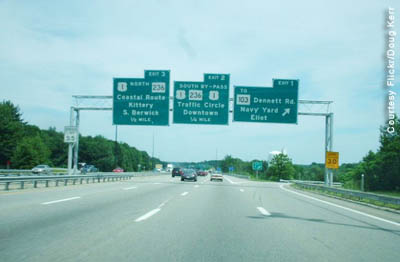Maine Turnpike

The first superhighway in New England and the second modern toll highway in the United States, the Maine Turnpike was the first major modern highway to be built without any state or federal funding.
Maine's heavy snows led turnpike maintenance personnel to bring "left-handed" snow plows into prominence. By using left-handed and traditional right-handed plows in tandem, they were able to distribute snow more evenly - an important advance that has been emulated by many highway maintenance crews across the country.
In a state known for conservatism and tradition, Maine broke the mold in 1947 with the completion of the nation's second superhighway, the Maine Turnpike. Years before the Interstate Highway system, Maine set the standard for safety, efficiency and economy in highway construction, giving many motorists their first taste of driving at 60 mph - a mile a minute.
The first U.S. highway to be completely self-financed, the project broadened the purview of civil engineers, requiring them to consider revenue projections in addition to safety, cost and other design factors. Initial construction was funded through $20 million in revenue bonds that were repaid from motorists' tolls. To this day, the turnpike's construction, expansion, operation, and maintenance have not cost taxpayers, the state or the federal government a dime.
Facts
- The Maine Turnpike is one of the few remaining toll roads to generate all of its own operating capital, independent of any state highway department funding.
- The turnpike turned Maine into a major vacation destination. Today, 55 percent of tolls are paid by out-of-state travelers. The state's tourism revenues total $3 billion a year.
- Traffic has grown from 2,500 vehicles a day to 122,000, a 49-fold increase in just over 50 years. Over 12,000 trucks use the highway daily, carrying 90 percent of Maine's freight.
- In keeping with turnpike traditions of economic and environmental savings, 1.4 million old tires were put to use as fill for embankments on a recently completed interchange, reducing construction costs by $250,000 and avoiding the disposal of 13,000 tons of tires.

